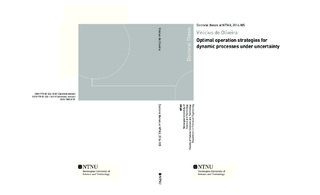Optimal operation strategies for dynamic processes under uncertainty
Doctoral thesis
Permanent lenke
http://hdl.handle.net/11250/2390285Utgivelsesdato
2016Metadata
Vis full innførselSamlinger
Sammendrag
The main focus of this thesis is to find implementation strategies for the optimal operation of processes during transients. That is, we do not focus on the algorithms to solve a given dynamic optimization problem, but on how to implement the solution in practice using control. The underlining theme is based on the general idea of finding feedback policies that give acceptable performance even in the presence of model uncertainties and disturbances. By 'acceptable' we mean that important constraints should always be satisfied and the economic performance should be near the optimal. In this thesis we considered different classes of applications, each one with their own particularities and challenges.
The first part of the work deals with the optimal operation of thermal energy storage systems. We consider the optimal operation of energy storage in buildings with focus on the optimization of an electric water heating system. The optimization objective is to minimize the energy costs of heating the water, with the requirement that we should satisfy the uncertain demand at any time. The main complications in this problem are the time varying nature of the electricity price and the unpredictability of the future water demand. First, we present a detailed problem formulation which may also be suitable similar problems. Many insights into the optimization problem formulation are given and guidelines on implementation strategies including feedback control structures are proposed.
Next, we use the hot water system as an example to illustrate our proposed implementation strategy based on hierarchical decomposition of the optimization-control problem. In our approach, economic objectives and control objectives are decoupled using a two-layer cascade feedback structure.
We show that the decomposed optimization problem can be written as a simple linear program (LP) which can be solved very efficiently. The main result is that great economical benefits can be obtained at a very low computational cost and suitable for low cost embedded hardware.
Part two of the thesis is dedicated to an intelligent anti-slugging control system for o shore oil production maximization. Existing anti-slug control systems are not robust and tend to become unstable after some time, because of inow disturbances or plant dynamic changes, thus, requiring constant supervision and retuning. A second problem is the fact that the ideal setpoint is unknown and we could easily choose a suboptimal or infeasible operating point. Here we present a method to tackle these problems. Our complete control solution is composed of an autonomous supervisor that seeks to maximize production by manipulating a pressure setpoint and a robust adaptive controller that is able to quickly identify and adapt to changes in the plant. Our proposed solution has been tested in a experimental rig and the results are very encouraging. An analysis of the robustness and optimality of different linear controllers for slug mitigation is also carried out in this part of the thesis.
In the last part of the thesis we discuss near-optimal operation strategies using simple feedback control. First, we generalize the neighbouring extremal control design that has been presented in the literature (Gros et al.,2009b) to explicitly handle measurement noise and implementation errors.
The bene ts of our method are illustrated in a case study where we show that the sensitivity of the controller performance to measurement noise is considerably reduced. Finally, we extended the concept of self-optimizing control (Skogestad, 2000; Alstad and Skogestad, 2007) for the near-optimal operation of transient processes. The main idea is to find a function of the measurements whose trajectory is optimally invariant to disturbances and then track the trajectory using standard feedback controllers. Doing so results in near-optimal economic operation in spite of disturbances without the need for re-optimization. We show that the invariant trajectories can be computed as linear combinations of the measurement vector, where the time-varying combination matrix is easily obtained from optimal sensitivities.
Består av
Paper 1: V. de Oliveira, J. Jãschke and S. Skogestad, Optimal operation of energy storage in buildings: Use of the hot water system. Journal of Energy Storage Volume 5, February 2016, Pages 102–112 http://dx.doi.org/ 10.1016/j.est.2015.11.009Paper 2: V. de Oliveira, J. Jãschke and S. Skogestad, Hierarchical control in dynamic optimization of energy storage systems
Paper 3: V. de Oliveira, J. Jãschke and S. Skogestad, Null-space method for optimal operation of transient processes. - Presented at IFAC International Symposium on Dynamics and Control of Process Systems, 2016. © 2016 IFAC.
Paper 4: V. de Oliveira, J. Jãschke and S. Skogestad, Neighbouring-Extremal Control for Process Optimization Using Noisy Measurements. International Symposium on Advanced Control of Chemical Processes, IFAC-PapersOnLine 2015 ;Volum 48.(8) s. 698-703 http://dx.doi.org/10.1016/j.ifacol.2015.09.050 © 2015 IFAC.
Paper 5: V. de Oliveira, J. Jãschke and S. Skogestad, An autonomous ap- proach for driving systems towards their limit: an intelligent adaptive anti-slug control system for production maximiza- tion. 2nd IFAC Workshop on Automatic Control in O shore Oil and Gas Production, IFAC-PapersOnLine 2015 ;Volum 48.(6) http://dx.doi.org/10.1016/j.ifacol.2015.08.017 © 2015 IFAC.
Paper 6: E. Jahanshahi, V. de Oliveira, C. Grimholt and S. Skogestad, A comparison between Internal Model Control PIDF, optimal PIDF and robust controllers for unstable ow in risers, IFAC World Congress, 2014. IFAC Proceedings series 2014 ;Volum 19. s. 5752-5759 http://dx.doi.org/10.3182/20140824-6-ZA-1003.02381 © 2014 IFAC.
Paper 7: V. de Oliveira, J. Jãschke and S. Skogestad, Dynamic online opti- mization of a house heating system in a uctuating energy price scenario, IFAC International Symposium on Dynamics and Control of Process Systems, 2013. IFAC Proceedings series 2013 s. 463-468 http://dx.doi.org/10.3182/20131218-3-IN-2045.00070 © 2013 IFAC.
